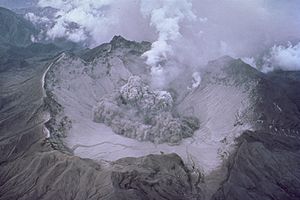Volcanic winter facts for kids
A volcanic winter happens when a very large volcanic eruption makes the climate much colder. This happens because the eruption shoots out huge amounts of ash and sulfur dioxide. These chemicals turn into tiny particles called aerosols of sulfuric acid.
When these particles reach the stratosphere (a high layer of Earth's atmosphere), they reflect more sunlight back into space. Some sunlight is also absorbed by the stratosphere, which makes that layer warmer. However, this leads to a big drop in temperature on the ground below.
Some of the largest volcanic events in Earth's history, like the Siberian Traps, Emeishan Traps, and Deccan Traps, were huge floods of lava. These events are thought to have caused, or at least contributed to, several mass extinctions, including the massive Permian–Triassic extinction event.
The idea of a nuclear winter describes similar effects that could happen after a large-scale nuclear war.
Volcanoes and Climate Change
Even though recent volcanic eruptions have only had a small effect on winters, their impact throughout history has been quite big.
For example, when Mount Pinatubo in the Philippines exploded in 1991, it cooled global temperatures for about two to three years.
In 1883, the huge explosion of Krakatoa in Indonesia caused conditions similar to a volcanic winter. The four years after the eruption were unusually cold. The winter of 1887 to 1888 even brought powerful blizzards and record snowfalls around the world.
The 1815 eruption of Mount Tambora, another volcano in Indonesia, led to what was called the "Year without a Summer" in 1816. During that year, there were frosts in mid-summer in New York State and snow in June in New England and Newfoundland and Labrador.
In the 1780s, Benjamin Franklin wrote about the unusually cool summer of 1783. He believed it was caused by volcanic dust from Iceland. The eruption of Laki volcano there had released huge amounts of sulfur dioxide. This led to many animals dying and a terrible famine that killed a quarter of Iceland's people. Temperatures in the northern hemisphere dropped by about 1 °C in the year after the Laki eruption.
In 1600, the Huaynaputina volcano in Peru erupted. Studies of tree rings show that 1601 was a very cold year. Russia suffered its worst famine from 1601 to 1603. From 1600 to 1602, Switzerland, Latvia, and Estonia had extremely cold winters. The grape harvest for wine was very late in France in 1601, and wine production completely failed in Peru and Germany. Peach trees bloomed late in China, and Lake Suwa in Japan froze earlier than usual.
Around 1452 or 1453, a massive eruption of an underwater volcano called Kuwae caused problems all over the world.
The Great Famine of 1315–1317 in Europe might have been made worse by a volcanic event. This could have been the eruption of Kaharoa in New Zealand, which lasted for about five years.
Images for kids
-
The supervolcano caldera Lake Toba
See also
 In Spanish: Invierno volcánico para niños
In Spanish: Invierno volcánico para niños



